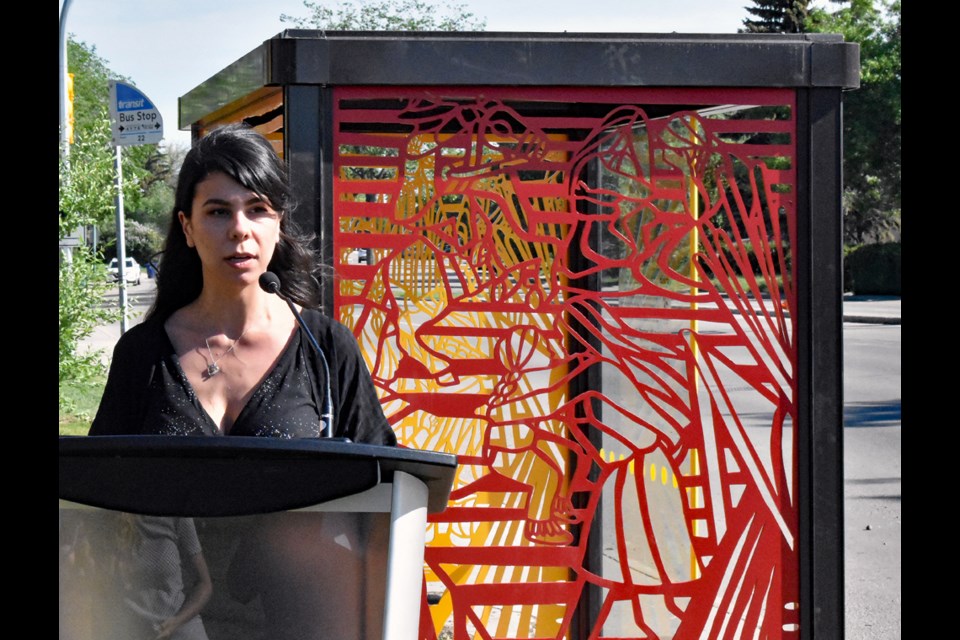SASKATOON — Pauline Okemow says residential school survivors are in different stages of healing and are using various ways to overcome the trauma they experienced while attending learning institutions, most of which were run by Roman Catholic religious groups, that were aimed to assimilate Indigenous children to the Western culture.
Okemow, Laureen Paul, Lorna Arcand and other members of the Saskatoon Survivors Circle witnessed this morning the unveiling of a bus shelter that shows their stories in artwork created by Regina-based Indigenous artist Justine “Tini” Stilborn, who spent hours talking to the group of residential school survivors to get an idea on how to transform their accounts visually.
“I think it promotes healing for us. Everybody is in a different stage of healing. Some have not yet healed; some have healed a little bit [and] some have healed a lot. But every day is a healing journey for us. Because I talked about the triggers. We're always triggered by something or someone, or some issue. We’re always going to be affected by it,” said Okemow.
“Our Zoom meetings did bring comfort to me knowing that we’re telling our story. We’re telling the people that this is what happened to us, even if they don’t believe us, it happened. You can see our people on the streets, homeless people, in dire need of so many things. We try to speak for them. Through this [bus shelter] art piece, people will see the story and understand it.”
Paul praised Stilborn for capturing the stories of the survivors that they discussed during their numerous conversations and meetings, as they focus on creating awareness.
“We have such an amazing artist to work with. She captured not just her feelings, but she was able to capture the truth as it was spoken. We had an amazing committee that worked together. There are triggers, but we work together and we support each other. This was meant to create awareness and if we can reach one person that uses the shelter, then that’s already a success for us and that is reconciliation,” said Paul.
Stilborn said she chose to do the project to help address the stigma and shame that has been associated with С����Ƶ Indigenous.
“I felt a lot of shame projected onto me as a child. Since becoming a mother and doing my own work, I’ve felt the need to reconnect with those parts of myself that I’ve denied. My great-grandmother was born in a teepee. Being a mother myself, I don’t want to just teach but demonstrate to my daughters that there’s a rich Indigenous culture to be proud of,” said Stilborn.
“I want this bus shelter to serve as my recognition, my reconnection story to my ancestors but also to allow residential school survivors across Canada an opportunity for reconnection to their inner child ... I hope this project will act as a learning tool for the community and be a beacon of truth.”
Saskatoon Transit acting director Tracey Davis said they were inspired to create the project following the discovery of unmarked graves in residential schools across Canada.
“Following the location of unmarked residential school graves, Saskatoon Transit was inspired to reach out to the Saskatoon Survivors Circle. Truth and reconciliation go hand-in-hand and this year was our opportunity to help … through this shelter installation,” said Davies.
Mayor Charlie Clark said the shelter is the city’s way of reaffirming its commitment to the Truth and Reconciliation Commission’s Call to Action No. 79 which calls on governments to collaborate with survivors, Aboriginal organizations and the arts community in developing a reconciliation framework for Canada's heritage and commemoration.
“Saskatoon Transit’s work with the Saskatoon Survivors Circle continues to advance reconciliation in Saskatoon. The stories of the survivors are the truth that we must understand that leads us towards meaningful reconciliation. This beautiful artwork is now a visual representation of the survivors’ stores,” said Clark.
Saskatoon Tribal Council Chief Mark Arcand thanked all the people that were involved in the project, especially the survivors who told their stories and Stilborn who transformed their experiences into artwork that can now be seen by those using the bus shelter.
“I think about today as another day in history where Saskatoon is understanding the TRC Calls to Action, but most importantly it’s an education and an understanding tool for the community. We talk about the trials and tribulations that are coming right from our people that have been traumatized through residential schools, now we have a chance to change the systems and make it better for all our people,” said Arcand.
The artwork’s story begins on the left panel, painted red to express the stereotype of Indigenous peoples’ skin and the bloodshed and pain they experienced. The panel shows the Sixties Scoop where Indigenous children were taken away from their families into the child welfare system.
The back panel, painted orange to coincide with Orange Shirt Day and Every Child Matters movements, demonstrates how Indigenous children were forced to assimilate into Euro-western culture by cutting their hair. It also represents the unmarked graves of children found in residential schools while the hands at the top reflect the connection that was broken between generations of Indigenous Peoples and the longing to reconnect.
The right panel is painted yellow that represents hope and joy, illustrating freedom of Indigenous Peoples as they return to their roots, practice their culture and traditions, and reconnect with their ancestors.
The bus shelter, located on the corner of Confederation Drive and Massey Place, is the fourth in the city that displays Indigenous artwork. The other locations are in front of Aiden Bowman Collegiate on Clarence Avenue С����Ƶ, 12th Street and Broadway Avenue and E.D. Feehan Catholic High School on the north side of Rusholme Road and west of Avenue M.




